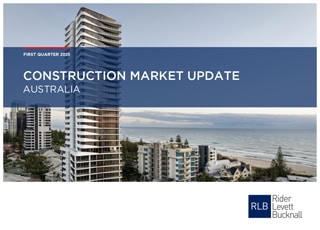Australia’s construction sector is under mounting pressure from two interrelated forces: new international tariffs and the depreciation of the Australian dollar. Rider Levett Bucknall’s Australia Market Intelligence Update – Q1 2025 unpacks these dynamics, identifying emerging challenges for developers, contractors and suppliers across the country.
While the long-term outlook remains stable, short-term volatility is expected to persist. As Director of RLB Oceania Research & Development, Ewen McDonald, explains: “Our construction industry operates within a globally integrated system that relies heavily on imported materials, equipment and technologies. Shifts in international trade, particularly US tariff policies, pose immediate and tangible risks to cost structures.”
Tariffs and trade policy: escalating import costs
Despite Australia’s existing free trade agreement with the United States, recent tariff changes are increasing the cost of US-manufactured construction goods. New duties on aluminium, HVAC systems, construction technologies and machinery are inflating procurement budgets, compressing developer margins and creating feasibility challenges for infrastructure and housing projects alike.
The weak AUD: compounding financial strain
At the time of reporting, the Australian dollar had fallen to its lowest level in five years. This decline is driving up the cost of imports from the US, China, Japan and the EU, with long-term contracts now facing margin erosion if currency risks were not adequately hedged.
What this means for the industry
The dual impact of tariffs and a weakened dollar is producing significant downstream effects:
- Inflated input costs across steel, mechanical systems, insulation and high-tech components
- Project delays due to disrupted procurement timelines and scheduling uncertainty
- Limited substitution opportunities, as some local products fail to meet compliance or quality benchmarks
- Elevated risk for fixed-price contracts, particularly where escalation clauses were not built in
To remain competitive, industry players will need to balance procurement strategy with greater financial and contractual agility.
Mounting cost pressures across the country
Across all major centres, cost pressures remain elevated. Labour shortages, rising wage expectations and low productivity continue to drive pricing volatility. While material costs had shown signs of stabilising in late 2024, the shifting global environment is now reversing that trend. Contractors are increasingly selective, and insolvency risks are being factored into pricing, especially on complex or fixed-price projects.
Governments remain the primary drivers of construction activity in many markets, particularly through investment in health, defence, education and transport infrastructure. However, private sector feasibility remains challenging, with developers contending with both rising costs and tighter access to capital.
Strategic focus for the year ahead
Australia’s construction sector will need to navigate carefully through 2025. Financial strategy, local capability development and proactive risk management will be key to weathering macroeconomic pressures.
As Ewen notes, “Despite the ongoing challenges, the Australian construction industry has opportunities to navigate these turbulent times. The next two years will be crucial for the construction sector, requiring careful strategic management to overcome obstacles and harness opportunities for growth.”
FURTHER INFORMATION:



